Alfred Kubin
Alfred Leopold Isidor Kubin (10 April 1877 – 20 August 1959) was an Austrian printmaker, illustrator, and occasional writer. Kubin is considered an important representative of Symbolism and Expressionism.
Alfred Kubin | |
|---|---|
 | |
| Born | Alfred Leopold Isidor Kubin 10 April 1877 |
| Died | 20 August 1959 (aged 82) Zwickledt, Wernstein am Inn |
| Nationality | Austrian |
| Education | Munich Academy |
| Known for | Painting |
| Movement | Symbolism, Expressionism |
Biography
Kubin was born in Bohemia in the town of Leitmeritz, Austro-Hungarian Empire (now Litoměřice). From 1892 to 1896, he was apprenticed to the landscape photographer Alois Beer, although he learned little.[1] In 1896, he attempted suicide on his mother's grave, and his short stint in the Austrian army the following year ended with a nervous breakdown.[1] In 1898, Kubin began a period of artistic study at a private academy run by the painter Ludwig Schmitt-Reutte, before enrolling at the Munich Academy in 1899, without finishing his studies there. In Munich, Kubin discovered the works of Odilon Redon, Edvard Munch, James Ensor, Henry de Groux, and Félicien Rops. He was profoundly affected by the prints of Max Klinger, and later recounted: "Here a new art was thrown open to me, which offered free play for the imaginative expression of every conceivable world of feeling. Before putting the engravings away I swore that I would dedicate my life to the creation of similar works".[2] The aquatint technique used by Klinger and Goya influenced the style of his works of this period, which are mainly ink and wash drawings of fantastical, often macabre subjects.[1] Kubin produced a small number of oil paintings in the years between 1902 and 1910, but thereafter his output consisted of pen and ink drawings, watercolors, and lithographs. In 1911, he became associated with the Blaue Reiter group, and exhibited with them in the Galerie Der Sturm in Berlin in 1913.[2] After that time, he lost contact with the artistic avant-garde.

Kubin is considered an important representative of Symbolism and Expressionism and is noted for dark, spectral, symbolic fantasies, often assembled into thematic series of drawings. Like Oskar Kokoschka and Albert Paris Gütersloh, Kubin had both artistic and literary talent. He illustrated the works of Edgar Allan Poe, E.T.A. Hoffmann, and Fyodor Dostoevsky, among others. Kubin also illustrated the German fantasy magazine Der Orchideengarten.[3][4]
From 1906 until his death, he lived a withdrawn life in a Manor-House on a 12th-century estate in Zwickledt, Upper Austria.[4] In 1938, at the Anschluss of Austria and Nazi Germany, his work was declared entartete Kunst or "degenerate art,"[5] but he managed to continue working during World War II.
The Other Side
Kubin's only written work was Die andere Seite (transl. The Other Side) (1908), a fantastic novel set in an oppressive imaginary land.[6][7][8][9] The novel has an atmosphere of claustrophobic absurdity similar to the writings of Franz Kafka, who admired the book.[4][10] The illustrations for the book were originally intended for The Golem by Gustav Meyrink, but as that book was delayed, Kubin instead worked his illustrations into his own novel.[3]
Honours and awards
- City of Vienna Prize for Visual Arts (1950)
- Grand Austrian State Prize for Visual Art (1951)
- Austrian Medal for Science and Art (1957)
- Gustav Klimt badge as an honorary member of the Vienna Secession
Collections
- Kubin's Dance of Death and Other Drawings (1973) (art collection) (ISBN 9780486228846)
- The Life and Art of Alfred Kubin (2017) (autobiography) (ISBN 9780486815305)
Gallery
.jpg) The State (1899–1900)
The State (1899–1900)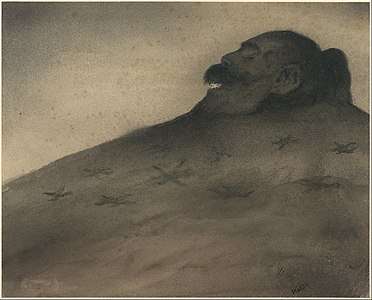 Dolmen (c. 1900–1902), indian ink, wash, spray paint, and white body color, Albertina, Vienna
Dolmen (c. 1900–1902), indian ink, wash, spray paint, and white body color, Albertina, Vienna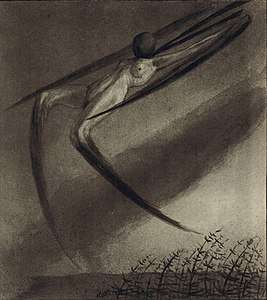 A Dream Visits us Every Night (1900)
A Dream Visits us Every Night (1900) The Past Forgotten Swallowed (1901)
The Past Forgotten Swallowed (1901)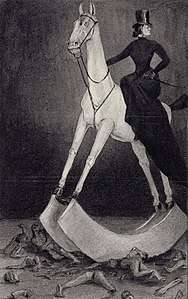 The Lady on the Horse (1901), pen, ink, wash and spray
The Lady on the Horse (1901), pen, ink, wash and spray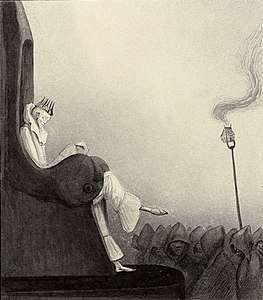 The Last King (1902)
The Last King (1902)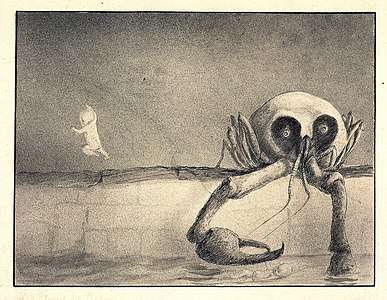 The Moment of Birth (1902)
The Moment of Birth (1902)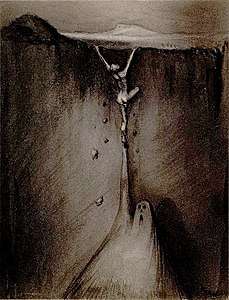 Angst (1903)
Angst (1903) Black Mass (1905)
Black Mass (1905)
Notes
- "Kubin, Alfred". Grove Art Online. doi:10.1093/gao/9781884446054.001.0001/oao-9781884446054-e-7000048160. Retrieved 16 April 2020.
- Arnason & Wheeler 1986, p. 88.
- Siegfried Schödel, Studien zu den phantastischen Erzählungen Gustav Meyrinks, Universität Erlangen-Nürnberg, 1965, (p.27).
- Rosenberg, Karen. 15 October 2008. Mapping the Shadowy Corners of the Subconscious. The New York Times. Retrieved 3 April 2012.
- Karl-Heinz Meissner, Alfred Kubin, Städtische Galerie im Lenbachhaus München, Edition Spangenberg, 1990 (p.114).
- "Artist creates a nightmare novel". The Canberra Times. Australian Capital Territory, Australia. 24 October 1970. p. 13. Retrieved 30 March 2020 – via Trove.
- Robyn Walton (2011), The Crime of Material Culture, the Condition of the Colonies and Utopian/Dystopian Impulses, 1908-10, retrieved 30 March 2020
- Kubin, Alfred; Lindley, Denver; Kubin, Alfred, 1877-1959. Autobiography (1969), The other side : a fantastic novel, Gollancz, ISBN 978-0-575-00345-3CS1 maint: multiple names: authors list (link)
- Kubin, Alfred, The Life and Art of Alfred Kubin, Dover 2017 (Bibliographic note). Viewable through Amazon.com's Look Inside feature for the book.
- Franz Rottensteiner,The Fantasy Book: An Illustrated History from Dracula to Tolkien (p. 143) Collier Books, 1978. ISBN 0-02-053560-0
References
- Arnason, H. H., & Wheeler, D. (1986). History of modern art: Painting, sculpture, architecture, photography. Englewood Cliffs, N.J.: Prentice -Hall. ISBN 9780133903607
- Assman, Peter Alfred Kubin 1877–1959 Exhibition catalogue Brussels (Ixelles) 1997
- Alfred Kubin Exhibition catalogue Neue Galerie New York 2008
- Romana Schuler Alfred Kubin, Aus meinem Reich Exhibition catalogue Leopold Museum Vienna 2003
- Traumgestalten. 100 Meisterwerke aus dem Besitz der Graphischen Sammlung Albertina Vienna 1990